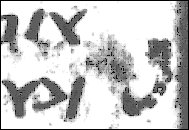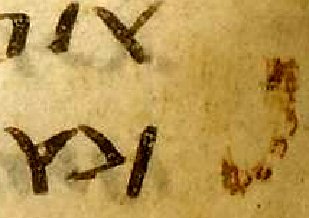|

This ancient Bible
manuscript
known by such names as:
-Codex
Washingtonensis-
-Washington Codex-
-Freer
Gospels-
-Codex W-
Is The only Known Set
Of First Century Gospel Manuscripts. Portions Of These Pages Are
Fully Original. This Is The Christian World's Most Precious Book,
Priceless In Value.
 . .
|
Washington Codex (Codex
W, Freer Gospels), says Dr. Lee W. Woodard, is
one
set of first century Greek originals of the four Gospels. Codex (Codex) W
enables resolution of the synoptic problem. These Gospels are dated with
Aramaic alpha numeric and pictorial symbols, telling the correct order and
relationship of the four Gospels. The Gospel of Matthew (crafted
originally in Damascus, Syria in AD
37, with some revision or re-penning of pages in 43 A.D.,
with final revision in Aun, Egypt in AD 67) was later used by John Mark
and his scribe, Barnabas, for writing the Gospel of Mark in
Antioch of Syria in about A.D. 69, followed by some editing and re-penning
of pages in Aun, Egypt in A.D. 73. Then Luke (also in
Antioch of Syria) used both Matthew and Mark's Gospels to fashion the Gospel of
Luke (AD
74).
[delete “then”]
John’s First Edition Gospel was first penned in A.D. 67, with some editing
or re-penning
[delete “penned the final version of the Gospel of John”]
in Ephesus
in AD
97.
Dr. Woodard’s Codex W: Old And Holy explains this great discovery
that is so important for New Testament Scholarship, enabling greater
understanding and appreciation of the four Gospels.
Places and dates of composition for each of the four Gospels are also told via
Codex W's previously unstudied symbolic art, and in previously overlooked
marginal entries of Aramaic. This newly discovered data enables final resolution
for the synoptic problem. Later we shall discuss "Q," German for "Quelle."
Codex W. is composed of our currently recognized Four Christian Gospels. These
were written in Greek by Jewish Christian Scribes. They include previously
unrecognized Aramaic and Greek dating, ranging from 37-97 AD, complete with
Aramaic Seals and Signatures! This Jewish-Christian-entered Aramaic in this
codex is sometimes written in very tiny (yet still recognizable) script. These
Jewish Christian mid-to-late First Century Scribes were trying to hide pertinent
data from dangerous and disastrous scrutiny by Hostile Non-Christian
Authorities. Such Aramaic Scribal entries are of huge significance for anyone
who would better understand the Four Gospels.
We can now see covertly (yet still adequately recognizable) Aramaic
alpha-numerically expressed dates of composition, and scribal-church community
locations of Matthew, Mark, Luke and John!
This book also presents what will become recognized as the definitive solution
to the so called "Synoptic" Problem, as well as the utter annihilation of that
modern era figment of imagination known as "Q."
Previous scholars made the incredibly inaccurate assessment that this codex
gives no indication of dates. Those analysts overlooked what are readily
recognizable, even though covert, multiplicity of First Century AD Aramaic
alpha-numeric representations of specific dates for each manuscript within this
bound collector’s edition of First Century AD Gospels.
Earlier analysts failed additionally to recognize that each of these Gospels
tells the exact year of Jesus’ Birth (750 AUC, our 4 BC) as well as the exact
year of Jesus’ Crucifixion (784 AUC, our 30 AD). No longer is it necessary to
speculate about any of these matters.
This codex enables us to know precisely when, where, and by whom each of the
Four Gospels were written, as well as where and when some slight changes and
additions to original manuscripts were made.
Codex W is the first and only set of First Century A.D. Gospel Namesake
Authorized and Issued manuscripts of the Four Gospels. More technically, this
is only known original First Century AD, Aramaic annotated, stamped, sealed, and
signed copies of Apostolic era manuscripts. This Codex even includes a wooden
book cover with painted representations of Matthew, John, Luke, and Mark (in
that order) on them. The artist probably was First Century AD Jewish Christian
Barnabas, cousin of John Mark, and the painted images of the Gospel Namesakes
were done circa 47-74, and likely accurately portray them.
|
Luke’s Aramaic Seal
from 74
AD, featured in the below picture, is just one of scores of First Century
AD Aramaic entries I have pictured and discussed in my book, “First
Century Gospels Found!”

|
Below is digital color photograph of the same detail featured in the black
and white exposure. The two exposures at the top are untouched
enlargements. In both black and white and in this color view, there is
recognizable hfna (--which I interpret as “Antioch”). –But what about the
entries that appear smeared in the black and white? That additional data
is considerably more legible in the color. –Which led to my deciphering
the srA “Aram.” (“Syria”).
The Resh (r) and final, block form of ending Mem (s) are very small and
are crowded on the bottom right of the much larger Aleph (A), but I eel
confident of that interpretation.
What I am now seeing, then, is srA--hfnA (“Antioch of Syrian”).
There is also a considerable amount of now terribly faded Semitic data to
the left of the right side
hfna “Antioch. I believe I can make out
qwL
“Luke” or maybe
sqwL “Lukas.” –But this is yet another instance where usages of
readily available Mass Spectrometry technology can enable discerning and
reading those now terribly faded additional entries.
Bottom
Right is my attempt to enhance what I now interpret as “Antioch of Syria.”
|



The Aramaic stamp-seal
saying "Antioch
of Syria"
|
a
n
f
h
mrA
|
Expanded from script
in
left columns |
I intentionally turned the Greek text upside down in order to feature the
First Century AD Aramaic Stamp-Seal of Luke, saying (most clearly)
"Athena" in right margin. Luke and John Mark entered their covert Aramaic
notations and seals upside down, as regards the Greek text, and wrote in
tiny script, to try to hide such data from the persecuting authorities.
The really big data visible in this picture is that marginal
seal-stamp, obviously in First Century AD styled Aramaic, covert and
small, yet readily visible and understandable.
|
What on earth can explain such clandestine Aramaic usage? The only answer
is that they were trying to hide that stamp of Apostolic
Orthodoxy (so
important to other Christian Communities) from those not in the know. The
only time frame in which this makes sense is about 73 AD, which is the
date of this stamp. That this covert method worked fairly well is attested
by modern scholars also overlooking it. But forensic paleographers are
supposed to minutely scrutinize such things, but obviously my predecessors
failed to do that.
A question
then arises: How did a First Century AD
styled Aramaic stamp seal for
Antioch wind up on
Luke's manuscript
in the 200 A.D. ruins of Soknopaiou Nesos (Dimet) The answer is (as portions of Church History attest —and even 1
Peter's 5:13 "Babylon"— Aun Egypt had a Roman Babylon Community in the First
Century) that
Barnabas, as primary scribe for
Mark, John, Matthew and Luke, hand
carried one set (this Codex W set)
of First Century Gospel Originals to Egypt. The effect of my discoveries about
this previously misdated set of First Century AD Gospel originals is sounding
the death knell for, and is indeed mercifully and humanly killing that figment
of imagination known as “Q.” It had been incorrectly assumed, contrary to best
evidences within Church History, and even contrary to Biblical evidences, that a
“more simple” Gospel of Mark was first written. Matthew and Luke then supposedly
came along, each independently using Mark’s earlier Gospel, and a modern era
theorized "Sayings Source" (known as "Q," representing German "Quelle," to
“expand and enhance” in keeping with later, “more-advanced-than-earlier-Mark's”
church conceptions and liturgies. Such earlier misconceptions can now be
corrected, and abandoned.
Click here to order
this
book







